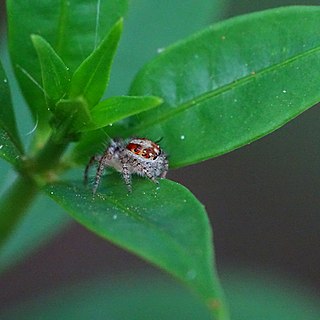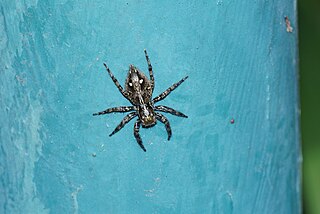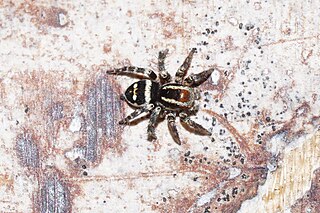Rhondes is a genus of New Caledonian jumping spiders that was first described by Eugène Louis Simon in 1901. It was briefly considered a synonym of Hasarius, but was revalidated after the results of a 2008 molecular study. It is now grouped with several other Australasian genera in the unranked clade Astioida.

Langona pilosa is a species of jumping spider in the genus Langona that lives in Namibia. The male was first described by Wanda Wesołowska in 2006 and the female in 2011. The spider is small with a cephalothorax between 2.2 and 3.1 mm long and a abdomen between 2.1 and 3.5 mm. The female is larger than the male. The spider has a brown carapace that has two white stripes on its back, a large dark patch on its yellowish abdomen, a black eye field and the toothless chelicerae typical of the genus. The male can be distinguished from others in the genus by the existence of tufts around the palpal bulb, after which it is named, and the very long and thin tibial apophysis. The female has copulatory organs that resemble Langelurillus ignorabilis but differ in the design of the seminal ducts.
Nigorella aethiopica is the type species of the genus Nigorella. A jumping spider that lives in Ethiopia and named in honour of the country in which it is found, it was first described in 2008 by Wanda Wesołowska and Beata Tomasiewicz. The spider is larger than others in the species with a cephalothorax that is between 4.1 and 4.8 mm long and an abdomen that is between 4.3 and 5.6 mm long. The carapace is generally brown and hairy, although the male is darker. While the male abdomen is marked by a light stripe on the topside and dots underneath, the female abdomen has a pattern of a light stripe and patches on the top and dark stripes on the bottom. As well as the larger size, there is a split at the end of the appendage on the pedipalp tibia that marks out the male, and the female has longer seminal ducts and thinner spermathecae than others in the genus.

Aelurillus timidulus is a species of jumping spider in the genus Aelurillus that is endemic to Ethiopia. It was first described in 2008 by Wanda Wesołowska and Beata Tomasiewicz. Only the female has been described. It is a small spider with a cephalothorax 2 mm (0.079 in) long and rounded abdomen 2.8 mm (0.11 in) long. The body is black at the front, dark brown at the back of the high pear-shaped carapace and greyish beige across the abdomen. It has a smaller epigyne than others in the genus, but the copulatory organs are otherwise similar to other Aelurillus spiders, having a central pocket and wings alongside the copulatory openings.

Aelurillus desertus is a species of jumping spider in the genus Aelurillus that is endemic to the United Arab Emirates. It was first described in 2010 by Wanda Wesołowska and Antonius van Harten. Initially only the male was described, the female following ten years later. The spider was originally classified in the genus Rafalus but was moved to its current genus at the same time as the female description was first published. The species is medium-sized with cephalothorax that is between 2.8 and 3.3 mm long and a abdomen that is between 2.8 and 4.8 mm long. The female is larger than the male. The carapace has a distinctive stripe. The female has three darker spots on the abdomen. The species can be distinguished by the existence of a triangular lobe on the palpal bulb on the male and the way that the copulatory openings are close to the rear of the epigyne on the female.

Langona bethae is a species of jumping spider in the genus Langona that lives in Botswana and Namibia. The male was first described in 2011 by Wanda Wesołowska and Meg Cumming. The spider is large with a cephalothorax between 2.6 and 3.5 mm long and a abdomen between 2.2 and 4.4 mm. The female is larger than the male. The spider has a brown carapace that has two white streaks on the thorax a black eye field. It has the toothless chelicerae typical of the genus. It can be distinguished by its abdominal pattern, which has a yellow streak of an irregular shape. The male has a hidden embolus that is shorter than that on the related Langona pilosa. The female has copulatory organs that resemble Langelurillus ignorabilis but differ in the design of the seminal ducts.

Langona tortuosa is a species of jumping spider in the genus Langona that lives in Namibia, South Africa and Zimbabwe. It was first described in 2011 by Wanda Wesołowska, based on a holotype from Caprivi. The spider is large with a cephalothorax between 2.4 and 2.8 mm long and a abdomen between 1.9 and 2.6 mm long. The female is larger than the male. It has the toothless chelicerae typical of the genus. It can be distinguished by its copulatory organs. The male has a hidden embolus that is shorter than that on the related Langona pilosa. The female has long seminal ducts.

Yogetor spiralis is a species of jumping spider in the genus Yogetor that is endemic to Ethiopia. It was first described in 2008 by Wanda Wesołowska and Beata Tomasiewicz. The spider is medium-sized, with a brown cephalothorax between 1.6 and 2.1 mm in length and abdomen between 1.8 and 2.6 mm in length. The species has three distinctive yellow stripes on the thorax and colourless hairs on its black eye field. However, the most distinguishing feature is the design of the copulatory organs. The male has a short thin embolus on a rounded palpal bulb. The female has an epigyne that is large, lightly sclerotized, and shaped like a heart. It has two pockets, two rounded depressions divided by a ridge and very long spiralling seminal ducts ending in small spherical receptacles. The species is named tor the shape of the seminal ducts.

Plexippus minor is a species of jumping spider in the genus Plexippus that lives in the United Arab Emirates. The male was first described by Wanda Wesołowska and Antonius van Harten in 2010 and the female in 2020. The spider is medium-sized with a cephalothorax between 3.1 and 3.8 mm long and an abdomen between 3.3 and 4.1 mm long. It has a shape and colouring typical of the genus. The male has a orange carapace while the female is brownish-fawn. The copulatory organs distinguish it from related species, particularly the male's shorter embolus and tibial apophysis and the female's wide pocket on its epigyne.
Bacelarella gibbosa is a species of jumping spider in the genus Bacelarella that is endemic to Nigeria. The spider has a distinctive shape to the carapace that gives the species its name, which can be translated hunchback. It was first described in 2012 by Wanda Wesołowska and Glavis Edwards. The spider is medium-sized with a cephalothorax that has a length between 3.1 and 3.8 mm and an abdomen that is between 2.6 and 3.4 mm long. The female is larger than the male. It is also generally lighter in colour, the male having a darker brown carapace, clypeus and legs. The species can be distinguished from others in the species by the male's round small palpal bulb and long thin embolus and the larger pocket in the female's epigyne.
Neaetha irreperta is a species of jumping spider in the genus Neaetha that lives in South Africa and Tanzania. First described in 2000 by Wanda Wesołowska & Anthony Russell-Smith, the spider is small, with a dark brown carapace that is between 1.2 and 1.4 mm long and a deep red-brown abdomen between 1.1 and 1.5 mm long. The abdomen has a pattern that is indistinct on the male, but a clearer set of grey lines and marks on the female, and this, along with the width of the abdomen, distinguishes the species from other in the genus. The male has a long embolus and the female's sclerotized epigyne has a central pocket and wide copulatory openings.
Neaetha maxima is a species of jumping spider in the genus Neaetha that lives in Ivory Coast and Nigeria. It was first described in 2011 by Wanda Wesołowska & Anthony Russell-Smith based on a holotype found near Ibadan. Only the female has been described. The spider is atypically large, over 10 mm (0.39 in) long, which is reflected in the species name. The genus name can be translated new aspect. It has a light brown carapace and yellow-white abdomen, with orange-brown legs. The epigyne has a distinctive central pocket and wide copulatory ducts.

Stenaelurillus kavango is a species of jumping spider in the genus Stenaelurillus that lives in Namibia. It was first described in 2014 by Wanda Wesołowska from a holotype specimen found in the Kavango Region, after which it takes its name. Only the female has been identified. The spider is small, with a brown cephalothorax 2.8 mm (0.11 in) long and abdomen 3.1 mm (0.12 in) long. The carapace is hairy, dark brown and has four white streaks, while the abdomen is brown-black with light stripes. It can distinguished from other members of the genus by the design of the epigyne, which is oval, and its bean-shaped spermathecae.

Phintella caledoniensis is a species of jumping spider in the genus Phintella that lives in New Caledonia. First described in 2009 by Barbara Patoleta, it was named after the island where it was found. The spider is small and has a brown cephalothorax with patches, the female being generally darker, and a grey or grey-brown abdomen. The female has distinctive bean-shaped spermatheca and the male a long and thin embolus.
Rhondes atypicus is an endemic species of jumping spider in the genus Rhondes that lives in New Caledonia. First described in 2016 by Barbara Patoleta, the species has been found on both Grande Terre and Isle of Pines, living in rainforests. It is small and slender, with a wide brown hairy cephalothorax and thinner abdomen. The abdominal markings differ between the male and female, which gives rise to the species name. The male light and dark patches on its abdomen, and has a longer and thicker embolus than other species in the genus. The female, which is larger, has a striped abdominal pattern, which distinguishes the species from the similar Rhondes flexibilis.
Rhondes berlandi is an endemic species of jumping spider in the genus Rhondes that lives in New Caledonia. First described in 2016 by Barbara Patoleta, the species has been found on both Grande Terre and Isle of Pines, living in rainforests. Only the female has yet to be described. It is small and slender, with a wide brown hairy cephalothorax and thinner abdomen that is patterned with light and dark patches. The species can be distinguished from the related Rhondes flexibilis by its wide epigynal pocket.
Rhondes flexibilis is an endemic species of jumping spider in the genus Rhondes that lives in New Caledonia. First described in 2016 by Barbara Patoleta, the species is common across the island, living in rainforests. It is small and slender, with a wide brown hairy cephalothorax and thinner abdomen that has a pattern of light and dark patches. The male, which is slightly larger, has a variably-shaped sclerite on the palpal bulb, after which the species is named. The female has a slightly less distinctive abdominal pattern and an epigyne with a relatively long and narrow pocket.
Rhondes zofiae is an endemic species of jumping spider in the genus Rhondes that lives in New Caledonia. Only the female has been described. First defined in 2016 by Barbara Patoleta, the species is unusually named after her mother. It is small and slender, with a wide light brown cephalothorax and thinner abdomen that is lighter and patterned with grey-brown patches. It can be distinguished from the related Rhondes atypicus by the position of its copulatory openings.
Neaetha wesolowskae is a species of jumping spider in the genus Neaetha that is endemic to Thailand. First described in 2020 by Barbara Patoleta & Marek Żabka, the spider is small with a brown carapace that between 0.86 and 1.49 mm in length and a abdomen that is between 0.97 and 1.2 mm long. The female is smaller than the male, and has a pattern of spots rather than lines on the abdomen. The male has a crescent-shaped embolus, which separates it from other species like Neaetha absheronica, Neaetha membrosa and Neaetha tomkovichi. The female is hard to tell from other members of the genus, but the epigyne has distinguishing ovoid, rather than crescent-shaped copulatory openings and spermathecae that are separated rather than lying together.
Bacelarella pavida is a species of jumping spider in the genus Bacelarella that is endemic to Ivory Coast. It was first described in 2001 by Tamás Szűts and Rudy Jocqué based on a holotype found near Appouasso. The spider is medium-sized with a dark brown carapace that has a length between 3.7 and 4.0 mm and a mottled abdomen that is between 3 and 4.5 mm long. The carapace has a yellow spot and the abdomen has a pattern of white bands and spots. The male differs from other spiders in the genus in having a short embolus. The female can be distinguished by the large plate on the epigyne and large flaps on the chamber at the entrance to the short copulatory ducts.






